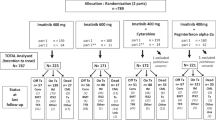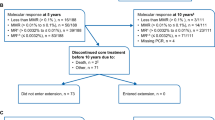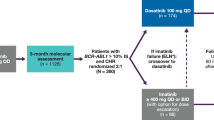Abstract
Tyrosine kinase inhibitors (TKI) have changed the natural course of chronic myeloid leukemia (CML). With the advent of second-generation TKI safety and efficacy issues have gained interest. The randomized CML - Study IV was used for a long-term evaluation of imatinib (IM). 1503 patients have received IM, 1379 IM monotherapy. After a median observation of 7.1 years, 965 patients (64%) still received IM. At 10 years, progression-free survival was 82%, overall survival 84%, 59% achieved MR5, 72% MR4.5, 81% MR4, 89% major molecular remission and 92% MR2 (molecular equivalent to complete cytogenetic remission). All response levels were reached faster with IM800 mg except MR5. Eight-year probabilities of adverse drug reactions (ADR) were 76%, of grades 3–4 22%, of non-hematologic 73%, and of hematologic 28%. More ADR were observed with IM800 mg and IM400 mg plus interferon α (IFN). Most patients had their first ADR early with decreasing frequency later on. No new late toxicity was observed. ADR to IM are frequent, but mostly mild and manageable, also with IM 800 mg and IM 400 mg+IFN. The deep molecular response rates indicate that most patients are candidates for IM discontinuation. After 10 years, IM continues to be an excellent initial choice for most patients with CML.
This is a preview of subscription content, access via your institution
Access options
Subscribe to this journal
Receive 12 print issues and online access
$259.00 per year
only $21.58 per issue
Buy this article
- Purchase on Springer Link
- Instant access to full article PDF
Prices may be subject to local taxes which are calculated during checkout




Similar content being viewed by others
References
O'Brien S, Guilhot F, Larson RA, Gathmann I, Baccarani M, Cervantes F et al. Imatinib compared with interferon and low-dose cytarabine for newly diagnosed chronic-phase chronic myeloid leukemia. N Engl J Med 2003; 348: 994–1004.
Druker BJ, Guilhot F, O'Brien SG, Gathmann I, Kantarjian H, Gattermann N et al. Five-year follow-up of patients receiving imatinib for chronic myeloid leukemia. N Engl J Med 2006; 355: 2408–2417.
Hochhaus A, O'Brien SG, Guilhot F, Druker BJ, Branford S, Foroni L et al. Six-year follow-up of patients receiving imatinib for the first-line treatment of chronic myeloid leukemia. Leukemia 2009; 23: 1054–1061.
Branford S, Yeung DT, Ross DM, Prime JA, Field CR, Altamura HK et al. Early molecular response and female sex strongly predict stable undetectable BCR-ABL1, the criteria for imatinib discontinuation in patients with CML. Blood 2013; 121: 3818–3824.
Falchi L, Kantarjian HM, Wang X, Verma D, Quintas-Cardama A, O'Brien S et al. Significance of deeper molecular responses in patients with chronic myeloid leukemia in early chronic phase treated with tyrosine kinase inhibitors. Am J Hematol 2013; 88: 1024–1029.
Mahon FX, Rea D, Guilhot J, Guilhot F, Huguet F, Nicolini F et al. Discontinuation of imatinib in patients with chronic myeloid leukaemia who have maintained complete molecular remission for at least 2 years: the prospective, multicentre Stop Imatinib (STIM) trial. Lancet Oncol 2010; 11: 1029–1035.
Ross DM, Branford S, Seymour JF, Schwarer AP, Arthur C, Yeung DT et al. Safety and efficacy of imatinib cessation for CML patients with stable undetectable minimal residual disease: results from the TWISTER study. Blood 2013; 122: 515–522.
Saglio G, Kim DW, Issaragrisil S, le Coutre P, Etienne G, Lobo C et al. Nilotinib versus imatinib for newly diagnosed chronic myeloid leukemia. N Engl J Med 2010; 362: 2251–2259.
Kantarjian H, Shah NP, Hochhaus A, Cortes J, Shah S, Ayala M et al. Dasatinib versus imatinib in newly diagnosed chronic-phase chronic myeloid leukemia. N Engl J Med 2010; 362: 2260–2270.
Mauro MJ, Deininger MW . Management of drug toxicities in chronic myeloid leukaemia. Best Pract Res Clin Haematol 2009; 22: 409–429.
Salie R, Silver RT . Uncommon or delayed adverse events associated with imatinib treatment for chronic myeloid leukemia. Clin Lymphoma Myeloma Leuk 2010; 10: 331–335.
Jabbour E, Deininger M, Hochhaus A . Management of adverse events associated with tyrosine kinase inhibitors in the treatment of chronic myeloid leukemia. Leukemia 2011; 25: 201–210.
Gambacorti-Passerini C, Antolini L, Mahon FX, Guilhot F, Deininger M, Fava C et al. Multicenter independent assessment of outcomes in chronic myeloid leukemia patients treated with imatinib. J Natl Cancer Inst 2011; 103: 553–561.
Thanopoulou E, Judson I . The safety profile of imatinib in CML and GIST: long-term considerations. Arch Toxicol 2012; 86: 1–12.
Breccia M, Alimena G . Occurrence and current management of side effects in chronic myeloid leukemia patients treated frontline with tyrosine kinase inhibitors. Leuk Res 2013; 37: 713–720.
Hehlmann R, Lauseker M, Jung-Munkwitz S, Leitner A, Mueller MC, Pletsch N et al. Tolerability-adapted imatinib 800 mg/d versus 400 mg/d versus 400 mg/d plus interferon-alpha in newly diagnosed chronic myeloid leukemia. J Clin Oncol 2011; 29: 1634–1642.
Hehlmann R, Müller MC, Lauseker M, Hanfstein B, Fabarius A, Schreiber A et al. Deep molecular response (MR4.5) is reached by the majority of imatinib-treated patients, predicts survival, and is achieved faster by optimized high-dose imatinib - results from the randomized CML-Study IV. J Clin Oncol 2014; 32: 415–423.
Fabarius A, Leitner A, Hochhaus A, Müller MC, Hanfstein B, Haferlach C et al. Impact of additional cytogenetic aberrations at diagnosis on prognosis of CML: long-term observation of 1151 patients from the randomized CML Study IV. Blood 2011; 118: 6760–6768.
Hanfstein B, Müller MC, Hehlmann R, Erben P, Lauseker M, Fabarius A et al. Early molecular and cytogenetic response is predictive for long-term progression-free and overall survival in chronic myeloid leukemia (CML). Leukemia 2012; 26: 2096–2102.
Hanfstein B, Shlyakhto V, Lauseker M, Hehlmann R, Saussele S, Dietz C et al. Velocity of early BCR-ABL transcript elimination as an optimized predictor of outcome in chronic myeloid leukemia (CML) patients in chronic phase on treatment with imatinib. Leukemia 2014; 28: 1988–1992.
Saussele S, Lauseker M, Gratwohl A, Beelen DW, Bunjes D, Schwerdtfeger R et al. Allogeneic hematopoietic stem cell transplantation (allo SCT) for chronic myeloid leukemia in the imatinib era: evaluation of its impact within a subgroup of the randomized German CML Study IV. Blood 2010; 115: 1880–1885.
Baccarani M, Saglio G, Goldman J, Hochhaus A, Simonsson B, Appelbaum F et al. Evolving concepts in the management of chronic myeloid leukemia: recommendations from an expert panel on behalf of the European LeukemiaNet. Blood 2006; 108: 1809–1820.
Baccarani M, Cortes J, Pane F, Niederwieser D, Saglio G, Apperley J et al. Chronic myeloid leukemia: an update of concepts and management recommendations of European LeukemiaNet. J Clin Oncol 2009; 27: 6041–6051.
Hasford J, Baccarani M, Hoffmann V, Guilhot J, Saussele S, Rosti G et al. Predicting complete cytogenetic response and subsequent progression-free survival in 2060 patients with CML on imatinib treatment: the EUTOS score. Blood 2011; 118: 686–692.
Hughes T, Deininger M, Hochhaus A, Branford S, Radich J, Kaeda J et al. Monitoring CML patients responding to treatment with tyrosine kinase inhibitors: review and recommendations for harmonizing current methodology for detecting BCR-ABL transcripts and kinase domain mutations and for expressing results. Blood 2006; 108: 28–37.
Cross NCP, White HE, Müller MC, Saglio G, Hochhaus A . Standardized definitions of molecular response in chronic myeloid leukemia. Leukemia 2012; 26: 2172–2175.
Müller MC, Cross NC, Erben P, Schenk T, Hanfstein B, Ernst T et al. Harmonization of molecular monitoring of CML therapy in Europe. Leukemia 2009; 23: 1957–1963.
Lauseker M, Hanfstein B, Haferlach C, Schnittger S, Pfirrmann M, Fabarius A et al. Equivalence of BCR-ABL transcript levels with complete cytogenetic remission in patients with chronic myeloid leukemia in chronic phase. J Cancer Res Clin Oncol 2014; 140: 1965–1969.
Branford S, Fletcher L, Cross NCP, Müller MC, Hochhaus A, Kim D-W et al. Desirable performance characteristics for BCR-ABL measurement on an international reporting scale to allow consistent interpretation of individual patient response and comparison of response rates between clinical trials. Blood 2008; 112: 3330–3338.
Pfirrmann M, Hochhaus A, Lauseker M, Sausele S, Hehlmann R, Hasford J . Recommendations to meet statistical challenges arising from endpoints beyond overall survival in clinical trials on chronic myeloid leukemia. Leukemia 2011; 25: 1433–1438.
Berman E, Nicolaides M, Maki RG, Fleisher M, Chanel S, Scheu K et al. Altered bone and mineral metabolism in patients receiving imatinib mesylate. N Engl J Med 2006; 354: 2006–2013.
Fitter S, Dewar AL, Kostakis P, To LB, Hughes TP, Roberts MM et al. Long-term imatinib therapy promotes bone formation in CML patients. Blood 2008; 111: 2538–2547.
Vandyke K, Fitter S, Dewar AL, Hughes TP, Zannettino AC . Dysregulation of bone remodeling by imatinib mesylate. Blood 2010; 115: 766–774.
Larson RA, Druker BJ, Guilhot F, O'Brien SG, Riviere GJ, Krahnke T et al. Imatinib pharmacokinetics and its correlation with response and safety in chronic-phase chronic myeloid leukemia: a subanalysis of the IRIS study. Blood 2008; 111: 4022–4028.
Kantarjian HM, Hochhaus A, Saglio G, De Souza C, Flinn IW, Stenke L et al. Nilotinib versus imatinib for the treatment of patients with newly diagnosed chronic phase, Philadelphia chromosome-positive, chronic myeloid leukaemia: 24-month minimum follow-up of the phase 3 randomised ENESTnd trial. Lancet Oncol 2011; 12: 841–851.
Cortes JE, Kim DW, Kantarjian HM, Brummendorf TH, Dyagil I, Griskevicius L et al. Bosutinib versus imatinib in newly diagnosed chronic-phase chronic myeloid leukemia: results from the BELA trial. J Clin Oncol 2012; 30: 3486–3492.
Baccarani M, Druker BJ, Branford S, Kim DW, Pane F, Mongay L et al. Long-term response to imatinib is not affected by the initial dose in patients with Philadelphia chromosome-positive chronic myeloid leukemia in chronic phase: final update from the Tyrosine Kinase Inhibitor Optimization and Selectivity (TOPS) study. Int J Hematol 2014; 99: 616–624.
Atallah E, Durand JB, Kantarjian H, Cortes J . Congestive heart failure is a rare event in patients receiving imatinib therapy. Blood 2007; 110: 1233–1237.
Kim TD, Rea D, Schwarz M, Grille P, Nicolini FE, Rosti G et al. Peripheral artery occlusive disease in chronic phase chronic myeloid leukemia patients treated with nilotinib or imatinib. Leukemia 2013; 27: 1316–1321.
Giles FJ, Mauro MJ, Hong F, Ortmann CE, McNeill C, Woodman RC et al. Rates of peripheral arterial occlusive disease in patients with chronic myeloid leukemia in the chronic phase treated with imatinib, nilotinib, or non-tyrosine kinase therapy: a retrospective cohort analysis. Leukemia 2013; 27: 1310–1315.
Cortes JE, Kantarjian HM, Goldberg SL, Powell BL, Giles FJ, Wetzler M et al. High-dose imatinib in newly diagnosed chronic-phase chronic myeloid leukemia: high rates of rapid cytogenetic and molecular responses. J Clin Oncol 2009; 27: 4754–4759.
Cortes JE, Baccarani M, Guilhot F, Druker BJ, Branford S, Kim DW et al. Phase III, randomized, open-label study of daily imatinib mesylate 400mg versus 800mg in patients with newly diagnosed, previously untreated chronic myeloid leukemia in chronic phase using molecular end points: tyrosine kinase inhibitor optimization and selectivity study. J Clin Oncol 2010; 28: 424–430.
Hughes TP, Branford S, White DL, Reynolds J, Koelmeyer R, Seymour JF et al. Impact of early dose intensity on cytogenetic and molecular responses in chronic- phase CML patients receiving 600 mg/day of imatinib as initial therapy. Blood 2008; 112: 3965–3973.
Preudhomme C, Guilhot J, Nicolini FE, Guerci-Bresler A, Rigal-Huguet F, Maloisel F et al. Imatinib plus peginterferon alfa-2a in chronic myeloid leukemia. N Engl J Med 2010; 363: 2511–2521.
Deininger MW, Kopecky KJ, Radich JP, Kamel-Reid S, Stock W, Paietta E et al. Imatinib 800 mg daily induces deeper molecular responses than imatinib 400 mg daily: results of SWOG S0325, an intergroup randomized PHASE II trial in newly diagnosed chronic phase chronic myeloid leukaemia. Br J Haematol 2014; 164: 223–232.
Sasaki K, Kantarjian HM, Jain P, Jabbour E, Pemmaraju N, Wierda WG et al. Ten-year follow up of patients with newly diagnosed chronic myeloid leukemia in chronic phase treated with 400 mg or 800 mg of imatinib daily. J Clin Oncol 2014; 32: Abstract 7024.
Simonsson B, Gedde-Dahl T, Markevarn B, Remes K, Stentoft J, Almqvist A et al. Combination of pegylated IFN-alpha 2b with imatinib increases molecular response rates in patients with low- or intermediate-risk chronic myeloid leukemia. Blood 2011; 118: 3228–3235.
Acknowledgements
The CML IV study was supported by the Deutsche Krebshilfe (Nr. 106642); Deutsches Kompetenznetz für Akute und Chronische Leukämien (BMBF 01GI0270); Deutsche José-Carreras Leukämiestiftung (DJCLS H09/01 f, H06/04v, H03/01, R05/23); European LeukemiaNet (LSHC-CT-2004-503216); Novartis, Nürnberg; Roche, Grenzach-Wyhlen; and Essex Pharma, Munich, all in Germany. We thank Elke Matzat, Andrea Elett, Regina Pleil-Lösch, Inge Stalljann, Gabriele Bartsch, Uwe Böhm, Sabine Dean and all participating investigators with their teams for their contributions.
Author information
Authors and Affiliations
Consortia
Corresponding author
Ethics declarations
Competing interests
SS has received honoraria from Novartis, Bristol-Myers Squibb (BMS), Pfizer and research funding from Novartis and BMS; MCM honoraria and research funding from Novartis, BMS, ARIAD and Pfizer; BH honoraria from BMS and research funding from Novartis; AN honoraria from Medupdate; CS honoraria for consulting from Novartis; MP honoraria from BMS and consultancy from Novartis; AH honoraria from Novartis, BMS,ARIAD, consultancy from Novartis and research funding from Novartis, ARIAD and Pfizer and RH has research funding from Novartis and BMS. The remaining authors declare no conflicts of interest.
Rights and permissions
About this article
Cite this article
Kalmanti, L., Saussele, S., Lauseker, M. et al. Safety and efficacy of imatinib in CML over a period of 10 years: data from the randomized CML-study IV. Leukemia 29, 1123–1132 (2015). https://doi.org/10.1038/leu.2015.36
Received:
Revised:
Accepted:
Published:
Issue Date:
DOI: https://doi.org/10.1038/leu.2015.36
This article is cited by
-
Survival with chronic myeloid leukaemia after failing milestones
Leukemia (2023)
-
Cardiovascular Adverse Events of Tyrosine Kinase Inhibitors in Chronic Myeloid Leukemia: Clinical Relevance, Impact on Outcome, Preventive Measures and Treatment Strategies
Current Treatment Options in Oncology (2023)
-
Guidelines for the treatment of chronic myeloid leukemia from the NCCN and ELN: differences and similarities
International Journal of Hematology (2023)
-
Role and mechanistic actions of protein kinase inhibitors as an effective drug target for cancer and COVID
Archives of Microbiology (2023)
-
Revisiting potential value of antitumor drugs in the treatment of COVID-19
Cell & Bioscience (2022)



